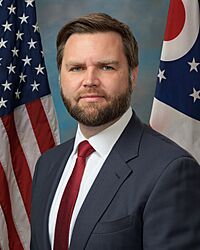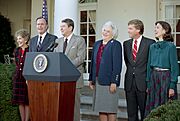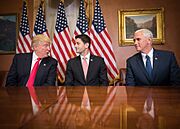Vice President-elect of the United States facts for kids
Quick facts for kids Vice President-elect of theUnited States of America |
|
|---|---|
| Style | The Honorable |
| Term length | In the period between the general election on Election Day in November and Noon (Eastern Standard Time) on Inauguration Day |
| Inaugural holder | John Adams January 10, 1789 |
| Formation | No official formation |
| Salary | None |
The vice president-elect of the United States is the person who has won the election to become the vice president of the United States. They are waiting to officially start their job. This happens after the United States presidential election but before the inauguration ceremony.
The U.S. Constitution doesn't say exactly when someone becomes the vice president-elect. However, the Twentieth Amendment uses the term. This means the term is officially recognized.
This title is similar to the "president-elect of the United States". That's what we call the person elected president of the United States during the same waiting period.
If a vice president is already in office and wins re-election, they are usually not called "vice president-elect." This is because they are already serving. They are not waiting to become vice president.
Contents
How Vice Presidents-Elect Are Chosen
Often, when a new vice president is elected, a new president is also elected. But this is not always the case. Sometimes, a president gets re-elected, but with a new running mate for vice president. This can happen if the old vice president was not chosen to run again.
For example, in 1944, Harry S. Truman became vice president-elect. He replaced Henry A. Wallace while Franklin D. Roosevelt was re-elected president.
Sometimes, the vice president position was empty before the election. This happened in 1964. Hubert Humphrey was elected with Lyndon B. Johnson. The vice president spot was empty because Johnson became president after John F. Kennedy passed away.
Since 1968, every new vice president has been elected alongside a new president.
It's also possible for a current vice president to win re-election with a new president-elect. This means there would be a change in presidents, but not in vice presidents. This happened in 1808. Vice President George Clinton was re-elected with James Madison becoming president-elect.
What Vice Presidents-Elect Do During the Transition

Many vice presidents-elect are chosen at the same time as a new president-elect. This means they are part of the team that helps the new government get ready. This period is called a presidential transition.
Just like the president-elect, the vice president-elect gets help from the government. The General Services Administration gives them money, office space, and services. This includes transportation and communication. This helps them prepare for their new role.
The role of vice presidents-elect in these transitions can be different. Some have played a big part. For example, Dick Cheney and Mike Pence were in charge of their transitions.
Bill Clinton included Vice President-elect Al Gore a lot in his 1992–93 transition. They made many important decisions together. Jimmy Carter also let Vice President-elect Walter Mondale help. Mondale gave ideas for who should work in the new government.
However, some presidents-elect have not included their vice presidents-elect much. For instance, Richard Nixon was not very involved in Dwight D. Eisenhower's transition in 1952–53. Later, when Nixon became president-elect, Spiro Agnew was also largely uninvolved in his transition.
-
Vice President-elect Dan Quayle (second from right) with his wife Marilyn. They are with Vice President and President-elect George H. W. Bush and his wife Barbara. Outgoing president Ronald Reagan and his wife Nancy are also there. This was during a press conference in 1988–89.
-
Vice President-elect Joe Biden (left) with President-elect Barack Obama. They are at a press conference during their transition in 2008–09.
-
Vice President-elect Mike Pence (right) with President-elect Donald Trump (left). They are meeting with Speaker of the House Paul Ryan during their transition in 2016–17.
What Happens if a Vice President-Elect Cannot Serve?
If a vice president-elect passes away or resigns before the Electoral College meets, the winning party's national committee would choose a new person. They would do this with the president-elect's help. This new person would then receive the electoral votes. If enough electors agree, that person would become the new vice president-elect.
If this happens after the electoral votes are cast, most experts believe no replacement would be chosen. Instead, the new president would pick a vice president after taking office. This is allowed by the Twenty-fifth Amendment to the United States Constitution.
Vice President-Designate
Before 1967, the Constitution had no way to fill an empty vice president spot during a term. So, if the vice president left office, the position stayed empty until the next election.
Since 1967, the vice president position has been empty twice. Both times, a new person was chosen to fill the spot. This was done using the 25th Amendment.
The first time was in 1973. Gerald Ford was chosen by President Richard Nixon after Spiro Agnew resigned. The second time was in 1974. Ford became president after Nixon resigned. Then, Ford chose Nelson Rockefeller to be vice president.
These people were called "vice president-designate." This is different from "vice president-elect" because they were not chosen by an election.
List of Vice Presidents-Elect





